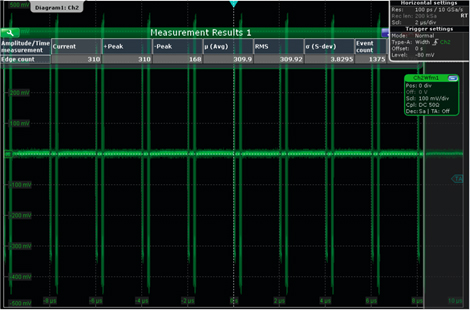Relevant Documents
 (198KB)
(198KB)
Background
The testing of USB devices, hosts, and hubs is carried out according to the requirements of the USB (Universal Serial Bus) Specification and the USB-IF Compliance Program. USB testing requires the use of probes and additional USB devices.
One crucial characteristic to be tested is receiver sensitivity, which refers to the minimum magnitude of input signal required to produce an output with a specified signal-to-noise ratio. The USB-IF Compliance receiver sensitivity tests – also referred to as EL16, EL17, and EL18 – require use of an arbitrary waveform generator.
Requirement
Receiver sensitivity is measured for devices and the upstream ports of hubs by applying a signal from a waveform generator to the input of the device or hub, and observing the response of the device or hub.
These tests verify the sensitivity of the receivers of a device on both the upstream and downstream data ports in noisy environments.
The AWG is required to transmit IN packets to be acknowledged by the device or hub. The sensitivity is determined by reducing the level of the signal from the waveform generator and observing when the DUT no longer responds.

Figure 1: Trace from a receiver sensitivity test. The smaller amplitudes show the stimulus signal from the Tabor AWG, the larger amplitudes show the response from the DUT.
Squelch (EL_16)
The squelch test is designed to make sure that the receiver does not respond to packets when the input’s differential amplitude falls below 100 mV.
Receiver Sensitivity (EL_17)
The receiver sensitivity (“unsquelch”) test is designed to make sure that the receiver receives and responds to packets when the input’s differential amplitude exceeds 150 mV.
12-bit SYNC field test (EL_18)
The 12-bit SYNC field test check certifies the ability of the receiver to receive and respond to packets with the shortest possible SYNC field (whose length may range from 12 to 32 bits).
Solution
Tabor Electronics’ WaveXciter family of High Speed Arbitrary Waveform Generators (AWGs) serves as an excellent platform for the testing of USB receiver sensitivity with its dual channels synchronous differential outputs and support of High-Speed USB data rates of 480 Mbps and more.
WaveXciter’s advanced sequencing capabilities allows you to quickly create and edit complex waveforms, which can be easily combined and repeated as required by the application.
WaveXciter is supplied with ArbConnection – Tabor’s comprehensive software tool that controls AWG operation, and supports the creation of unique, arbitrary waveforms using its powerful Waveform Composer.
For comprehensive USB compliance testing Tabor Electronics recommends the fully automated USB 2.0 compliance test solution offered by Rohde & Schwarz. The solution includes automation software, a Rohde&Schwarz RTO series oscilloscope and a Tabor WX2182B AWG.
For More Information
To learn more about Tabor’s solutions or to schedule a demo, please contact your local Tabor representative or email your request to [email protected]